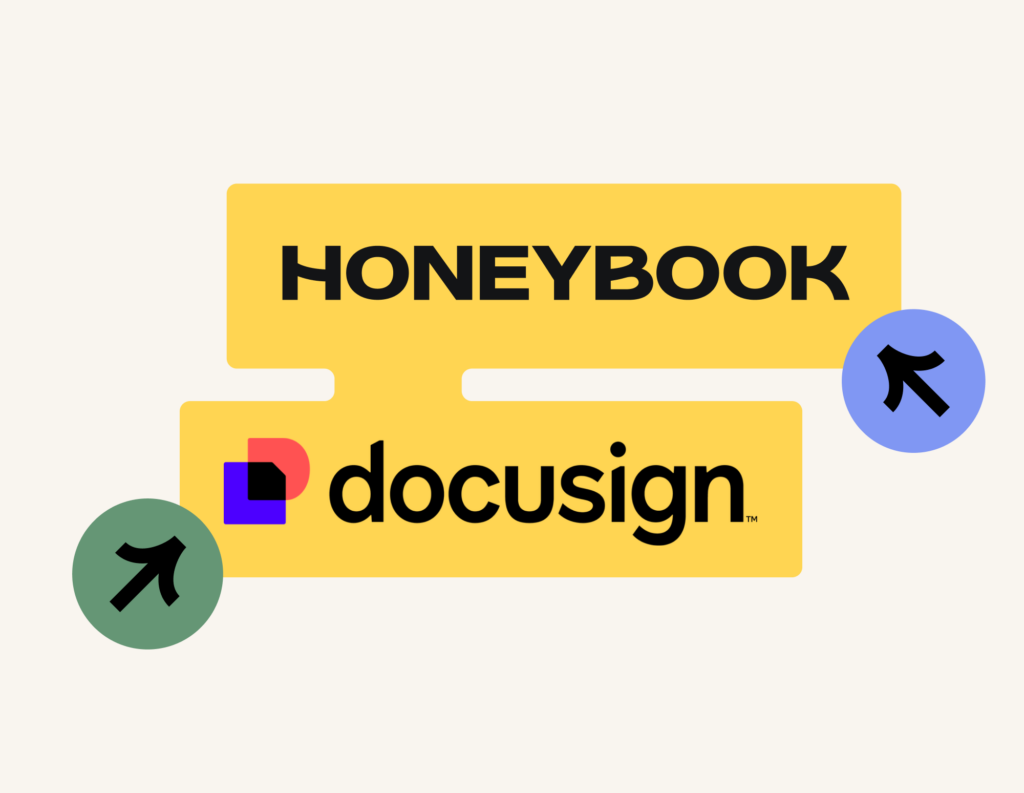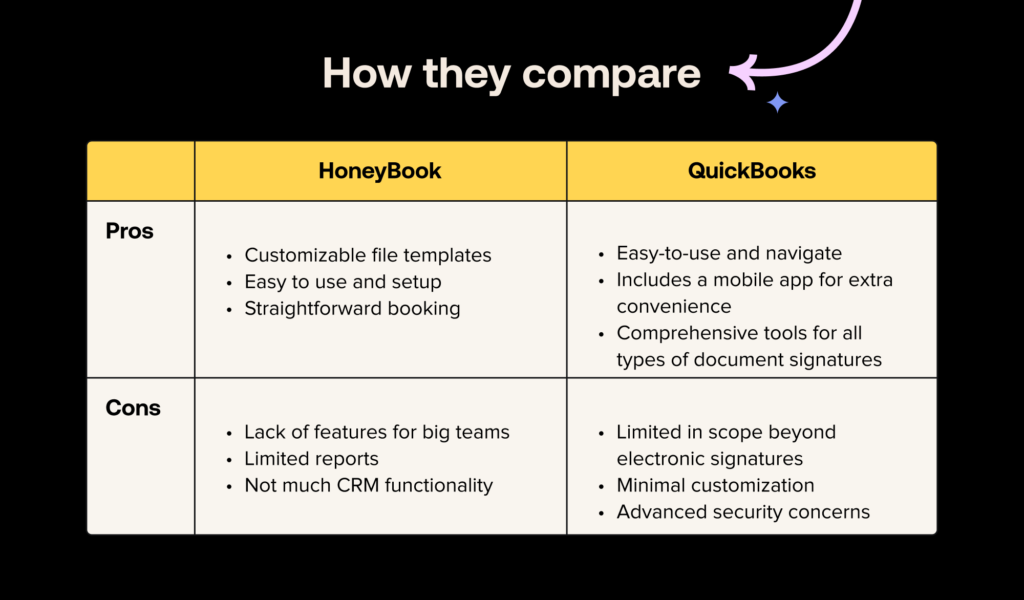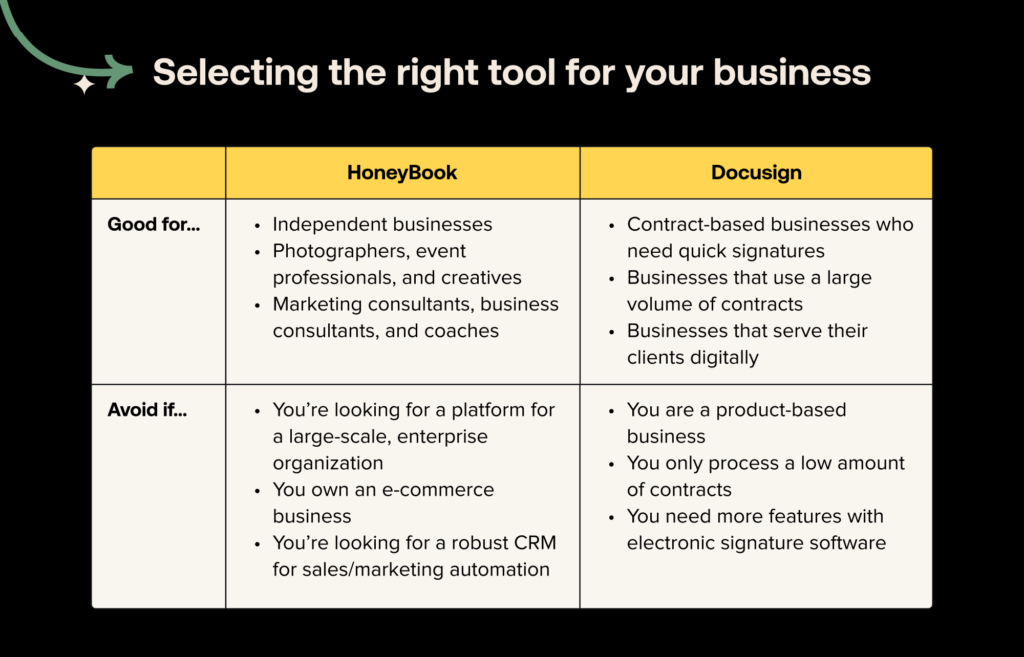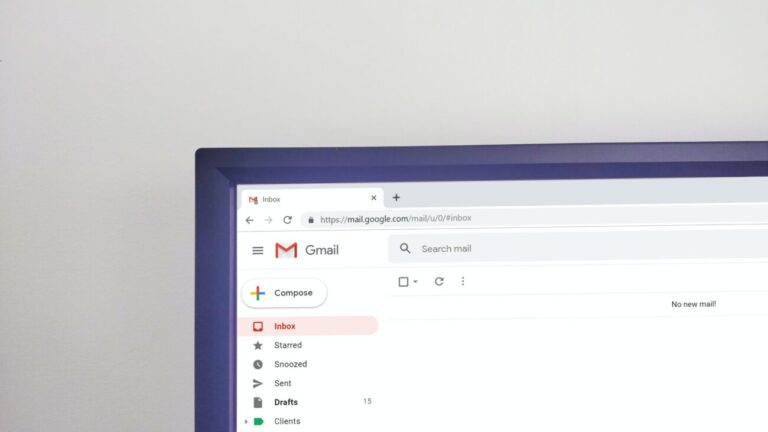Docusign is well known for facilitating contract eSigning, but how does it compare to a more all-in-one business management platform like HoneyBook? Compare HoneyBook vs. Docusign below to find out.

Docusign is a well-known and well-loved platform for businesses of all sizes, but is it the best option for small businesses? For independents like photographers, marketing consultants, event planners, and more–contract signing is just one piece of managing projects and client relationships.
I wanted to compare Docusign to HoneyBook to see how it stacked up to an all-in-one tool. Read more to see what Docusign is best for and if HoneyBook offers enough contract management features to replace Docusign altogether.


Jump to:
- Electronic signature
- Contract management
- Invoicing
- Payments
- Templates
- Client communication
- Lead management
- Integrations
- Mobile app
- Reports
- Customer support
- Pricing
- Summary
Electronic signature
Who wins out?
It’s a toss up; Both HoneyBook and Docusign have an extensive library of contract templates that include the ability to eSign from any device.
HoneyBook
HoneyBook offers a wide variety of contract templates that clients can eSign either on desktop or mobile. All contracts are legally vetted, but it’s also easy to edit them as needed and drop in your specific business and client information.
You can also use HoneyBook smart fields to auto-populate information like names, dates, locations, and more.
With HoneyBook, I especially love automating my contract signing process. I can schedule contracts to send as soon as I’ve finished a discovery call with someone so they have immediate access to review the scope and even pay directly from the contract file.
HoneyBook also enables me to set up automatic reminders so I can nudge clients to sign after a few days, and I don’t have to worry about keeping track of that process.

Use ready-made attorney-review contract templates on HoneyBook.

Docusign
The bread and butter of the Docusign software, the electronic signature, revolutionized how businesses complete contracts, and it has the numbers to back it up. In 15 minutes or less, 44% of users complete their contracts, and 80% finish them within one day.
I was able to add my customized logo and my brand colors to help customers recognize the contracts. The commenting features and customizable templates allowed my team to easily create new contracts while making adjustments in real time.
Signer identification protocols protect all contracts with robust threat protection services. The software has specialized features built for entrepreneurs like insurance agents and finance consultants.
The main issue I faced while using the electronic signature features was the amount of glitches and bugs I endured. While the tool makes eSignatures efficient, you may spend all the time you saved redoing your work.
Contract management
Who wins out?
Docusign offers more robust contract lifecycle management features for businesses, which is particularly helpful for enterprise-level or larger companies.
HoneyBook
Whether I’m using a HoneyBook-made contract template or one of my own, HoneyBook makes it easy to save my contract templates in organized folders. Plus, I can keep an eye on the status of my contracts in the project or client workspaces. From there, I have all of the information I need in one place to refer to when I sent a contract and when the due date is for signature.
Docusign
No matter what stage you are in the contract, the Contract Lifecycle Management features from Docusign help you create, manage, and meet compliance.
During my Docusign use, I integrated data from Salesforce, and Docusign automatically created documents from the data. Then, I set conditional rules that helped me maintain the integrity of my contracts, like reviewing non-standard terms when used in the contract.
The automation saved my team time by automatically routing the contracts to my internal and external teams for quicker document review. They could leave comments, and I could use artificial intelligence (AI) to help negotiate terms if clients were delaying signatures.
Invoicing
Who wins out?
HoneyBook offers robust invoice templates that you can customize to include other client actions like contract signing and scheduling, while Docusign offers a less all-in-one experience.
HoneyBook
As soon as you create a HoneyBook account, you have access to invoice templates that are easy to customize and use–whether you need a general invoice or a version that’s built specifically for your company type.
Like HoneyBook’s other templates, you can edit your invoice templates or build from scratch using a drag-and-drop editor that supports text, video, and images. I was able to easily incorporate my company brand to make sure my invoices were personalized.
The best part about HoneyBook invoices is the ability to include other actions, like service selection, contract signing, file upload, questionnaires, and scheduling. With every invoice, HoneyBook includes integrated payment processing, so your clients don’t have to jump into another service to pay.
For instance, I can use an all-in-one booking file that includes my meeting scheduler, an invoice for the session, a contract, and payment processing.
Docusign
The Document Generation feature is the closest Docusign comes to creating invoices for your clients. It has templates to choose from, and I could customize each one with my business information. Adding the pre-built data fields allowed me to connect pre-existing data to my documents, saving me even more time from manually inputting everything myself.
Unfortunately, no native payment gateway is available to accept pay from clients. You can’t offer a seamless experience where customers sign your contract and pay for your services in one interaction using only Docusign. You’ll need a payment system that integrates with the software to manage the transactions.
Payments
Who wins out?
Though Docusign offers the ability to integrate some payment gateways, it isn’t a good solution for businesses who need to invoice for their services. HoneyBook wins out for its integrated payment processing and the ability to add invoicing to contracts.
HoneyBook
With integrated payment processing in your invoice templates, HoneyBook makes it faster for you to get paid. In fact, 90% of HoneyBook invoices get paid on time.
Through HoneyBook, I accept credit card and ACH payments and enjoy some of the lowest transaction fees in the industry, starting at 2.9% + 25¢ for cardholder-entered payments. For reference, PayPal’s cardholder entered fees start at 2.99% + 49¢.
While the integrated payments are helpful for me, I could see that some may not like the inability to choose their own payment processor.
One thing I really love about HoneyBook is that you don’t have to chase payments. You can turn on automatic payment reminders and autopay, along with late payment fees for clients who pay past their due dates.
For greater organization, HoneyBook also enables you to track payment statuses in one place. Plus, view your profit and loss and get greater accounting insights with a seamless integration to Quickbooks.

Offer multiple payment options with HoneyBook and get paid directly through your invoices.
Docusign
Small businesses can use Docusign for more than just creating contracts and agreements. The platform includes Docusign Payments to enable business to also accept payments.
Here are the payment gateways that Docusign allows you to connect:
- Authorize.Net: ACH bank transfer and credit card
- PayPal Braintree: credit card
- CyberSource: credit card; one-time payments only
- Elavon: ACH bank transfer and credit card; one-time payments only
- Stripe: ACH bank transfer, SEPA bank transfer, credit card, Google Pay, and Apple Pay
- Zuora: credit card; save payment method only
Though the payment gateway integration makes it easier to accept payments, I found the process to be a little limiting. You can include different payment fields in your documents that prompt users to pay before signing, but the integration doesn’t serve as an invoice.
If you need an invoice to articulate your scope of work and services, Docusign Payments isn’t the best fit, but it can be helpful for businesses that are accepting one-time payments for services, like a single event or workshop.
Templates
Who wins out?
Though Docusign offers contract templates and web forms, HoneyBook offers a greater variety of file templates to manage your business and help you work more efficiently.
HoneyBook
File templates are one of HoneyBook’s strong suits. With an account, you already have a great starting point for every aspect of your clientflow: the process from capturing and qualifying leads to booking clients, managing projects, and maintaining relationships.
You can access all of the following templates, plus build your own:
- Lead forms
- Questionnaires
- Invoices
- Contracts
- Proposals
- Pricing and services guides
- Sales brochures
- Scheduling forms
- Welcome packets
- Project closure files
HoneyBook’s template gallery also offers a variety of templates that are specific to different industries, and are designed by business owners themselves.
Docusign
I found file templates in the Web Forms and Document Generation features. Web Forms allowed me to capture data from clients through my website. With no coding knowledge, I could generate full web forms, connect them to my site, and capture data through Docusign.
Under the Document Generation feature, I could create several agreements with clients, each with different terms and conditions. It was all templated for me, so I could easily choose what I wanted and customize it for my business.
Docusign also offers an extensive library of contract templates to help you get started.
Client communication
Who wins out?
Docusign offers SMS, WhatsApp, and email notifications to communicate with clients about their documents. But if you’re looking for more client communication, HoneyBook is a better fit to enable you to communicate with clients in one place and share their project information.
HoneyBook
With HoneyBook, I don’t have to worry about sifting through emails or missing client communication. You can integrate any email provider with your account so you’re able to see client emails inside your workspaces. The only downside is that you have to start an email thread in your HoneyBook account, so it won’t pull in all of your emails in your inbox.
From there, you can leverage HoneyBook email templates, set up automated emails at key moments (like after a lead inquires), and even use HoneyBook’s personalized AI-drafted emails that you can edit and send, saving hours while maintaining your unique voice. I personally love setting up email automations for my inquiries to make sure I respond quickly and save time providing information to them.
Though I didn’t set one up, you also have the opportunity to create a branded client portal that clients can use to view communications and files in one place.

Use HoneyBook to manage all of your client communication in one place.
Docusign
There is an option to add SMS and WhatsApp delivery to your document e-signature. While paying extra for the service may additionally burden small companies, it’s increasingly important for businesses of any size to meet customers where they are active digitally.
Using this feature, I could send real-time notifications to clients on their mobile devices via SMS or WhatsApp. The mobile experience lets clients sign contracts and documents on the go from anywhere in the world.
WhatsApp is one of the most popular communication apps worldwide, with millions of people using it across countries. Moreover, the app doesn’t charge fees for sending messages internationally. According to Docusign, WhatsApp messages have a 98% open rate and a 40% response rate.
Lead management
Who wins out?
Though Docusign offers Web Forms, they’re more for instant booking than lead capture. HoneyBook also offers capabilities for instant booking, but with greater capabilities for capturing leads on your different channels.
HoneyBook
HoneyBook offers two options for capturing leads: a standard contact form and a more robust lead form. Both are customizable, but the HoneyBook contact form is a simple way to capture leads, while lead forms enable you to add additional actions, like scheduling a meeting and paying up front.
You can share both forms on your public channels or privately to capture interested leads. I especially like the fact that you can choose from templates or build from scratch and save multiple forms for different audiences.
Once leads inquire, HoneyBook captures them and adds them to your account and project pipeline. I’ve customized my pipeline to match the steps I use to move leads forward to booking, which makes lead management easier. Plus, I like that you can manage all your communication and files in one project workspace with leads and clients.
Another great feature is HoneyBook automations, which I’ve used to set up instant responses and guide leads through next steps, such as filing out a questionnaire, scheduling time, and booking. You can also leverage HoneyBook AI to move faster on leads. When I have leads that seem more likely to book or book a more valuable project with me, I get a notification to let me know that I should respond ASAP. I can then use Email drafts to quickly create a message for them that uses the information they’ve provided. This is a really great standout feature I’ve noticed from HoneyBook.
HoneyBook does have it’s limitations with lead management. It doesn’t operate as a traditional CRM where you can score leads or nurture them and access other sales features like marketing automation. In my use, I think its lead management is great for independent businesses that don’t have a large volume of leads.
Docusign
One of Docusign’s more convenient features is its ability to create web forms that live on your site pages. Clients can access the forms at any time and complete them at their convenience. It’s a simple way to gather lead data, and Docusign has specific tools to customize the experience for each user.
I didn’t have any technical coding experience, but I used the drag-and-drop editor to create contracts quickly and effortlessly. There were fields I could add to a contract that would automatically sync with my app to collect the data. Using data from previously completed forms, Docusign populates new forms quickly for faster completion.
The dynamic content populates specific fields and information based on the client’s answers in the form. This ensures all your data is accurate and relevant to your contract management.
Integrations
Who wins out?
Docusign offers a much more robust library of integration options.
HoneyBook
HoneyBook offers the following integrations:
- Email and calendar (multiple platforms): Integrate your Gmail, Outlook, iCloud, or other email provider to centralize your client communication and calendar.
- QuickBooks: Sync your income information from HoneyBook into QuickBooks for more comprehensive online accounting (only one-way sync from HoneyBook to QuickBooks).
- Calendly: Integrate with Calendly to sync Calendly meetings onto your HoneyBook calendar or pull information from your HoneyBook calendar into Calendly.
- Facebook: Integrate with Facebook Lead Ads so you can populate your new leads directly into HoneyBook.
- Pic-Time: If you’re a photographer, you can use the Pic-Time integration to create new galleries, connect existing ones, and see the status of connected galleries all from HoneyBook.
- Zapier: Use Zapier to automate more with your favorite tools, like Trello, Asana, Clickup, Google Drive, and more.
Docusign
You’ll have no issue integrating Docusign with the other tools in your system. The app connects with over 900 apps in almost every category relevant to your client contracts.
Here are some of the bigger brands included in the integration list:
- Microsoft
- Salesforce
- Zoom
- Oracle
- SAP
If you and your team have developers, you can integrate the Docusign application programming interface (API) into your process to streamline data connections. The app includes an eSignature API, Docusign CLM API, and Docusign Click API.
Mobile app
Who wins out?
Both apps are companion versions of the software and enable you to create, send, and sign contracts on mobile. However, HoneyBook does have more robust features for on-the-go work.
HoneyBook
Within the HoneyBook mobile app, you can view your project pipeline to see statuses at a glance, plus view and edit your task list. You’re also able to manage your calendar and share your scheduler link along with other client communication, like sending and editing files.
Though you can customize your notifications, you have the option to get notified when you have a new message, when a client views a file, when someone signs a contract or pays an invoice, and when you have a task coming up.
Another great feature of the mobile app is time tracking. If you price your services by the hour, the time tracker enables you to stay on top of your working hours, then easily create an invoice directly from your tracked time.
Though the app is robust, I find it to be more of a companion to the desktop site since it doesn’t offer all of the same capabilities.
Docusign
The Docusign mobile app is a more limited version of the entire software, but it still lets you manage and organize contracts effortlessly, no matter where you are. Once logged in, I could create contracts quickly and sign them just like I could on my desktop.
If clients weren’t taking action quickly, the app allowed me to send out notifications and monitor all of my contract statuses. Using the photo technology on my mobile device, I took pictures of contracts and documents and uploaded them to the mobile app for even more convenience.
Having a streamlined approach to contract signing by letting your clients sign and see contracts using their mobile devices will significantly cut manual work and any bottlenecks. Clients can sign documents with the tips of their fingers, and you can store a signature template for quicker signing.
Reports
Who wins out?
HoneyBook overall offers more business reporting related to booking clients, not just your contract management. But, if you’re interested in more insights into your contracts, Docusign does have AI tools that can give you the information.
HoneyBook
HoneyBook offers several reports to provide insights on things like:
- Monthly bookings
- Booking rate
- Collected payments
- Outstanding payments
- Refunded payments
Though you can select a specific time frame to view each report, it is a bit limiting that you can’t customize any of the reports.
By capturing leads through the HoneyBook contact form, I’m able to use the lead source report to view where my leads come from and which lead sources are the most important in terms of value, conversion, and time to book. This information is invaluable for my marketing efforts and helps me understand the broader value of my marketing on different channels.
Premium HoneyBook users can also access team member and client reports.
Docusign
Docusign is constantly collecting contract data on client behavior. The tool then centralizes the data, and AI technologies look over it to uncover key insights into the contract process.
AI employs natural language processing, machine learning, and rules-based logic to help find, filter, and analyze agreements across your business. It looks for ways to drive more revenue through contract adjustments, accelerate legal service delivery so you can get your business running quickly, and align all contracts with business policies.
Using the app, I could see agreements across my Docusign networks, network files, and external resources in one place. The added organization let me make quicker business decisions since I had all the information at my fingertips.
Customer support
Who wins out?
Both offer similar support solutions, including chat and help center resources. However, HoneyBook offers a bit more in the form of file transfer services and dispute resolution for payment issues.
HoneyBook
When you’re first getting started with HoneyBook you can access their free file setup service, which migrates existing files like your pricing lists, contract language, client questionnaires, and more. Within 72 hours, you’ll have your templates successfully added to your HoneyBook account, all without lifting a finger.
HoneyBook offers live chat and email support seven days a week from 7 a.m. to 7 p.m. PT, along with an AI chat resource that can help answer questions easily and quickly.
You can also leverage HoneyBook’s self-service resources like its Help Center and live and on-demand webinars.
A great benefit of HoneyBook is that it offers one-on-one dispute resolution, so you’re in good hands if you’re faced with a client chargeback. If you receive a dispute, a HoneyBook Dispute Specialist will work with you to collect evidence and respond to your band on your behalf.
HoneyBook doesn’t offer any phone support, except for billing issues and dispute resolution.
Docusign
Docusign offers comprehensive online resources and customer service support to help its new and existing users navigate the tool. The website has a resource center full of articles that explain the different elements of Docusign and how to use each feature. But the tool also offers learning plans and custom training to help users get the most from Docusign. There’s also a community board where peers post problems, and experts from the community chime in with potential solutions.
Anytime I couldn’t find an answer to my question, I could open a case for additional support from the Docusign team. However, this didn’t always mean my issues received support. At times, it was hard to get a hold of the team and talk to someone directly to address the problems with the software. It might be easier for you to reach out to the community for a faster response.
Pricing
Who wins out?
HoneyBook offers more value for the price. Unlike DocuSign, which charges per user and limits agreements, HoneyBook includes unlimited clients, projects, and built-in automation without extra fees. It’s the better choice for businesses needing more than just e-signatures.
HoneyBook
| Starter | Essentials | Premium |
| $29/mo billed yearly | $49/mo billed yearly | $109/mo billed yearly |
| – Unlimited clients and projects – Invoices and payments – Proposals and contracts – Calendar – All professional templates – Client portal – Basic reports | – Scheduler – Automations – QuickBooks Online integration – Up to 2 team members – Expense management – Profit and loss – Remove Powered by HoneyBook – Standard reports | – Unlimited team members – Priority support – Multiple companies – Onboarding specialist – Advanced reports |
Docusign
| Personal | Standard | Business Pro |
| $10/mo billed yearly | $25/user/mo | $40/user/mo |
| – 5 envelopes (digital containers for agreements) – Reusable templates – 900+ templates | – All personal plan features, plus: – Shared templates – Collaborative commenting – Customized branding | All Personal and Standard features, plus: – Signer attachments – Formulas and advanced fields – Web forms – Bulk send – Payment collection |
Summary
Overall, HoneyBook and Docusign have very different offerings with a slight overlap. If you’re an independent business owner looking to protect your business with contracts, both can get the job done. However, HoneyBook does a better job of combining contract signing with the other crucial tools you need, like invoicing, payment processing, and scheduling.
Docusign only offers contract signing and contract management, but it goes very deep in the features it offers in that area. I recommend Docusign more for larger business that have to handle a large volume of contracts at any given time, rather than for smaller businesses who might benefit more from an all-in-one system.
| HoneyBook | Docusign | |
| Pros | – Highly customizable file templates for every step of your clientflow – Designed for ease of use and simple setup (file migration included) – Strong booking features for invoicing, contracts, and payments | – Easy-to-use and navigate – Includes a mobile app for extra convenience – Comprehensive tools for all types of document signatures |
| Cons | – Lack of robust features for big teams – Limited reports – Not much traditional CRM functionality for sales or lead nurturing | – Limited in scope beyond electronic signatures – Customization options are minimal – Advanced security concerns for digital signatures |



